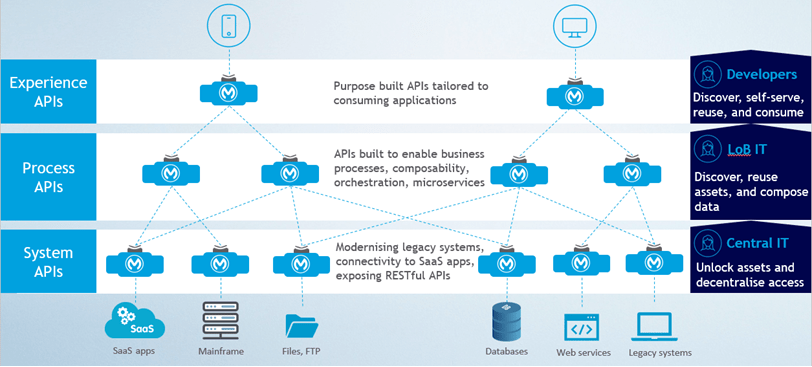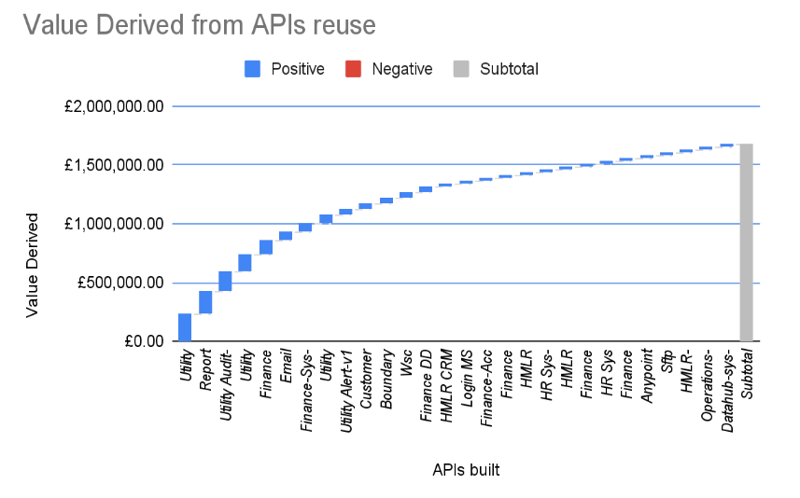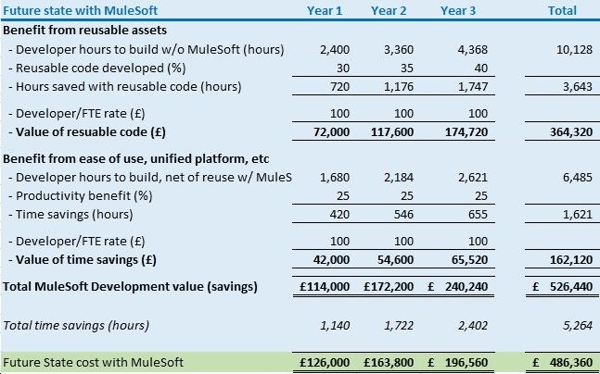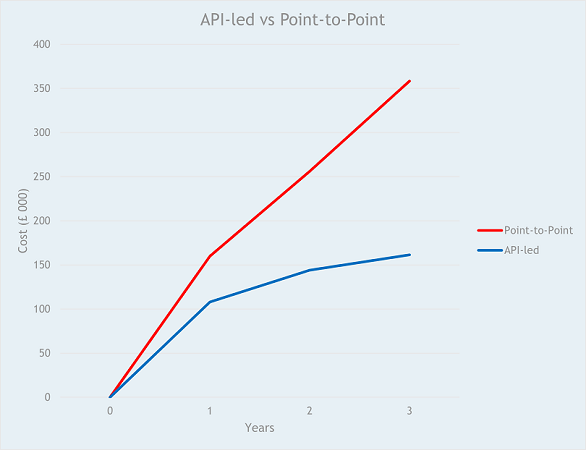
Considering the impact of recent world events, it is ever more critical for businesses to have a 'digital' first agenda. Digital transformations push the need for data-sharing between systems even further. An effective enterprise integration strategy becomes essential to successful digital changes.
Gartner predicts 65% of organizations will consider integration capabilities expenditures as strategic investments by 2024 (vs. 40% in 2019).
Our integration experts come across many companies choosing between a point-to-point approach to integration and investing in commercial integration platforms. This paper explains the pros and cons of both strategies and compares their value and financial implications.
According to Gartner, a point-to-point connection is 'a tightly coupled integration between two or more endpoints.' It is the simplest and most commonly used integration option. Adaptors to various platforms are available in the market; still, most require some level of customisation. Some organisations choose to develop bespoke connectors. Note that even if a system adaptor leverages APIs to access data, it still cannot be reused by other applications and, therefore, remains a point-to-point.
Developing a new connector doesn't take much time and effort, making this integration option so attractive for many companies. These projects are usually planned and executed in isolation from the rest of the organisation and are often seen as purely IT-related. Silos within organisations cause departments to focus only on their immediate priorities. There may be multiple integration projects within the same company, each vying for resources and budget while losing track of the organisation's broader goals.
A point-to-point integration option would be a perfectly acceptable solution for a small company with just a handful of applications and no growth plans. Still, in most cases, the price to pay for an ever-increasing number of one-to-one connections is too high. The fixed adaptors soon become unmanageable, unstable and very costly to keep in working order. Any connector developed to solve a specific project's purpose can unlikely be reused. Not to mention the wide IT skillset required to look after adaptors based on different technologies.
We frequently hear from customers that embarked on this approach a nervousness about enhancing or changing their existing applications. Any system upgrade or replacement requires a significant amount of modifications in its adaptors. In the worst-case scenario, a complete redevelopment is the only option. As a result, the organisation might eventually be left with an integration landscape that is in no way fit for modernisation, innovation and further growth.
.
Many businesses will seek new and approved approaches to building integrations over point-to-point and are keen to explore strategic platforms for building, deploying and managing integrations. MuleSoft is one of the market leaders and has become the top choice for many forward-thinking organisations. MuleSoft provides a powerful solution to facilitate API-based connectivity between applications, both on-premise and cloud-based. It is the only leader in the Gartner Magic Quadrant for both API Management and Enterprise Integration Platform as a Service (iPaaS).
The heart of MuleSoft is API-led connectivity - an architectural methodology that defines the approach for connecting and exposing assets through reusable and purposeful APIs. This approach shifts how IT operates, promoting decentralised access to data and capabilities while maintaining strong governance. The outcome of the API-led connectivity approach is a scalable and manageable network of 'pluggable' applications and devices.
Large enterprises have complex, interwoven integration needs that require multiple API-led connections. MuleSoft offers a framework for ordering and structuring these connectivity building blocks. Agility, flexibility and security can only come from a multi-tier architecture containing three distinct layers:
 3 layers of APIs.(source: MuleSoft: API-led connectivity)
3 layers of APIs.(source: MuleSoft: API-led connectivity)
The API-led approach provides numerous benefits, including exposing relevant core assets to a broader audience in a well-governed and secure way. Most importantly, it enables reuse and prevents duplication, thus reducing development time, costs and facilitating further growth.
His Majesty's Land Registry (HMLR) is an excellent example of how fast a company can start realising the benefits of the API-led approach leveraging MuleSoft. All HMLR's integration projects benefitted from the foundations laid at the program's start and reusable assets created during the previous projects.
Through careful planning, HMLR was able to reuse most APIs 70 times. If they had used a point-to-point approach, creating the additional 70 connections would have taken them an extra 16,800 hours and cost an additional £1,680,000 (based on the average developer rate of £100 per hour).

Organisations that are only starting their transformation journey assess various options for system integration. Our goal is to help IT leaders compare the ROI generated by MuleSoft-based and point-to-point approaches. We used our experience to create a template that demonstrates the financial and timeline gains from adopting MuleSoft in the long term.
We used the following key metrics typical for any project to compare the approaches:
We grouped the generated value into two main categories:
We selected a simple scenario where an organisation needs to develop 15 APIs in the first year, with 40% API growth in the second year and 30% in year three. We considered the time required to design, build, and deploy an integration/API, i.e., the full software development life cycle and the development costs. The table below shows a linear projection of the total expense caused by every new project developed from the ground up every time.
 3-year estimated cost of building direct system connections.
3-year estimated cost of building direct system connections.
In the following example, we use a 3-year prediction to demonstrate the cost and savings of the API-led connectivity with MuleSoft. We use the same number of development hours as the previous use case. This time, we applied a reuse factor associated with API reuse and the advantages of using a uniformed platform, such as the ease and speed of code development, deployment, and discovery. API reusability is expected to increase from 30%, 35% to 40% across years 1, 2 and 3, respectively. This reusability rate aligns with the actual data demonstrated in our previous use case with HM Land Registry.
Another significant benefit of using MuleSoft is the 25% increased productivity across three years. Having a platform with everything under one umbrella, from API Management and Monitoring to Build, Design and Security, to name a few, greatly improves work efficiency.
 3-year cost estimation of implementing API-led integration with MuleSoft.
3-year cost estimation of implementing API-led integration with MuleSoft.
Our integration experts can help with the overall cost of API-led integration with MuleSoft.
The key element of the API-led architecture is the reuse rate. Once the integration building blocks are created, the reuse percentage grows continuously. The speed of building the foundations will drive the timeline for reuse; however, the benefits are typically seen well within 12 months.
A deep understanding of business, its processes and goals help approach the APIs design with reuse in mind. APIs that are discovered and reused across the whole organisation contribute to the overall reduction of the development cost. There is no need to code from scratch every time a new project comes about.
On the other hand, a point-to-point approach does not drive reuse. The development costs associated with each integration remain and continue to scale linearly with every new project. Over time this strategy produces a web of integrations often called a 'spaghetti architecture'. Maintaining this mess and keeping the direct connections alive drains the company's IT resources and hinders growth.
This example demonstrates how cost savings can be realised in year 1 by taking an API-led approach. Over time, the cost savings increase due to the growing rate of APIs reused, reaching over £200K in the third year. Our calculations clearly demonstrate that the API-led connectivity approach is significantly more cost-effective and ensures that organisations get the maximum return from their investments.
 The following graph compares 3-year costs of point-to-point vs API-led connectivity with MuleSoft.
The following graph compares 3-year costs of point-to-point vs API-led connectivity with MuleSoft.

“The reason we chose MuleSoft was because, for us, it was the most complete solution. There’s more of a fully formed house with MuleSoft, whereby you don’t need quite so many people and you’re faster.
So, the total cost of ownership – while it’s more expensive in terms of the tin – is much higher in terms of long-term benefits.”
- CIO interview: Stephen Booth, CIO, Coventry University (computerweekly.com)
The most striking takeaway from our evaluation is that API-led integration is financially more cost-effective than a point-to-point approach. Furthermore, the gap between the two options widens over time as reuse increases. Undoubtedly, in some cases, the pressure to demonstrate immediate results, lack of communication, long-term vision and planning could make the point-to-point approach attractive. However, with the growing demand for new APIs and integration projects, these companies should be prepared for a steep cost increase over time.
The API-led integration is not just about reusing APIs across various projects and new business initiatives. You build a library of reusable assets by standardising commonly used components, including logging, security, error handling, and API specifications. Considering that most APIs use at least a few of these components, their reuse helps reduce the development time and costs enormously.
If we look at our example above, you see a £364K 'value' from API reuse across the 3 years, driven by the value of man-hours saved by leveraging earlier developed APIs.
MuleSoft has a pool of features that facilitate integration development needs and, therefore, help increase work productivity and efficiency. Mocking services, unified platforms, templates, and pre-built connectors speed up the implementation of integration solutions for various business problems. Many of MuleSoft's features require low code and even no code at all, thus reducing the probability of errors and test time and decreasing the pressure on the IT department.
In our example, a healthy £162K 'value' is generated by increased productivity, driven by man-hours saved using a unified platform.
MuleSoft's integration platform ensures stability, security and governance. IT teams, released from a heavy load of keeping the 'spaghetti' of connections alive, can finally focus on innovative ways to transform and grow the business. MuleSoft helps companies become efficient, agile, and respond faster to market demands.
The above calculations show a remarkable cost saving of over £500K due to assets reuse and the benefits of a unified integration platform like MuleSoft. These calculations are for demonstration purposes only and in no way reflect the overall integration cost. While this paper focuses entirely on the cost of labour, it's important to consider other expenses, including licensing, subscription, initial configuration and customisation, ongoing maintenance, training, etc.
We occasionally encounter concerns that a platform like MuleSoft has a steep entry point with its subscription-based licencing model. Organisations that focus entirely on short-term benefits often fail to apprehend the true value and opportunities generated by API-led connectivity. Building a living and breathing application network can take your company to an entirely new level, achieve a 360-degree customer view, open new revenue streams and reduce time to market. Integration-based transformation is not just about connecting a few systems and applications. It's about changing the old ways of thinking, working and serving customers.
We are passionate and share the joy of igniting ideas to fuel business visions. We are confident and are not afraid to boldly go where we’ve never been. We are also very friendly and approachable people who love to solve problems. Give our curious intelligent learners a challenge and we will make it work.
[fa icon="phone"]+44 (0)203 743 8014
[fa icon="phone"]+44 (0)203 875 5669 (Support)
[fa icon="envelope"]info@infomentum.co.uk
[fa icon="map-marker"]4th Floor
68 King William Street
London, EC4N 7HR, UK